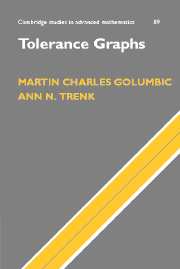Book contents
- Frontmatter
- Contents
- Chapter Dependencies
- Preface
- 1 Introduction
- 2 Early work on tolerance graphs
- 3 Trees, cotrees and bipartite graphs
- 4 Interval probe graphs and sandwich problems
- 5 Bitolerance and the ordered sets perspective
- 6 Unit and 50% tolerance orders
- 7 Comparability invariance results
- 8 Recognition of bounded bitolerance orders and trapezoid graphs
- 9 Algorithms on tolerance graphs
- 10 The hierarchy of classes of bounded bitolerance orders
- 11 Tolerance models of paths and subtrees of a tree
- 12 φ-tolerance graphs
- 13 Directed tolerance graphs
- 14 Open questions and further directions of research
- References
- Index of Symbols
- Index
12 - φ-tolerance graphs
Published online by Cambridge University Press: 11 August 2009
- Frontmatter
- Contents
- Chapter Dependencies
- Preface
- 1 Introduction
- 2 Early work on tolerance graphs
- 3 Trees, cotrees and bipartite graphs
- 4 Interval probe graphs and sandwich problems
- 5 Bitolerance and the ordered sets perspective
- 6 Unit and 50% tolerance orders
- 7 Comparability invariance results
- 8 Recognition of bounded bitolerance orders and trapezoid graphs
- 9 Algorithms on tolerance graphs
- 10 The hierarchy of classes of bounded bitolerance orders
- 11 Tolerance models of paths and subtrees of a tree
- 12 φ-tolerance graphs
- 13 Directed tolerance graphs
- 14 Open questions and further directions of research
- References
- Index of Symbols
- Index
Summary
We have already seen several generalizations of tolerance and bounded tolerance graphs in this book. In defining bounded bitolerance graphs (Chapter 5), we allowed the assignment of different tolerances to the right and left sides of the intervals. In defining NeST tolerance graphs (Chapter 11), we replaced the real line by a tree and the intervals were replaced by neighborhood subtrees. The class of bounded bitolerance graphs properly contains the bounded tolerance graphs, and class of NeST tolerance graphs properly contains the class of tolerance graphs.
We have also presented a number of restrictions of tolerance graphs such as the subclasses of unit tolerance graphs (Chapter 2), probe graphs (Chapter 4), and threshold tolerance graphs (Section 11.8). All of these, like interval graphs and permutation graphs, are properly contained in the class of tolerance graphs.
In all of our tolerance representations so far, an edge is added to the graphs when the size of the intersection of two intervals is large enough to “bother” one of them. In the case of tolerance, ij ∈ E ⇔ |Ii ∩ Ij| ≥ min{ti, tj}. In this chapter, we turn our attention to variations of this condition where the operation “min” is replaced by another binary function φ, for example “max” or “sum”.
Introduction
Let φ be a symmetric binary function, positive valued on positive arguments.
- Type
- Chapter
- Information
- Tolerance Graphs , pp. 193 - 218Publisher: Cambridge University PressPrint publication year: 2004



